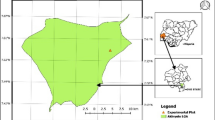Abstract
In the Zona da Mata Mineira of Southeastern Brazil the development of sustainable land requires the integration of crops with trees. The objectives of this study then were to (i) characterize prunings from the main tree species in an agroforestry system; (ii) determine the effects of the physical and chemical characteristics of the prunings on their decomposition patterns in the laboratory; (iii) assess the effect of mixing leaves of different species on decomposition rates; and (iv) propose a decomposition index for the residues studied. The study was carried out with pruning residues from Cajanus cajan, Solanum variable, Cassia ferruginea, Piptadenia gonoacantha, Croton urucurana, and Melinis multiflora. The materials were characterized for total C, N, P, Ca, Mg and K contents; lignin, cellulose, hemicellulose and soluble polyphenols contents. The pruning residues had high polyphenols and lignin contents, high C:N and C:P ratios, and low contents of Ca, Mg, and K. The low decomposition rates of the prunings were related to the P, K, hemicellulose and polyphenol contents. The rates of N mineralization from most of the residues indicate that there is a potential to supply the needs of a crop of maize. The residues of some species, if decomposed alone, would not supply sufficient nutrients, and need to be mixed with leaves of other species.
Similar content being viewed by others
References
Anderson J.M. and Ingram J.S.I. 1989. Tropical Soil Biology and Fertility: A Handbook of Methods. CAB International, Wallingford, UK.
Constantinides M. and Fownes J.H. 1994a. Nitrogen mineralization from leaves and litter of tropical plants: Relationship to nitrogen, lignin and soluble polyphenol concentrations. Soil Biology & Biochemistry 26: 49–55.
Constantinides M. and Fownes J.H. 1994b. Tissue-to-solvent ratio and other factors affecting determination of soluble polyphenols in tropical leaves. Communication in Soil Science and Plant Analyses 25: 3221–3227.
Diack M. 1994. Surface residue and root decomposition of cotton, peanut and sorghum. MS thesis, Purdue University, 166 p (unpublished).
Franco F.S., Carvalho A.F. and Couto L. 1994. Pre-diagnostico de sistemas agroflorestais da regiao de Vicosa-MG. In: Anais do Congresso Brasileiro de Sistemas Agroflorestais. Vol. 1. EMBRAPA-CNPF, Porto Velho.
Gijsman A.J., Alacon H.F. and Thomas R.J. 1997. Root decomposition in tropical grasses and legumes, as affected by soil texture and season. Soil Biology & Biochemistry 29: 1443–1450.
Goering H.K. and Van Soest P.J. 1970. Forage Fiber Analyses: Apparatus, Reagents, Procedures, and Some Applications. U.S. Department of Agriculture, Agricultural Research Service, Washington, DC, USDA ARS Handbook No. 379.
Golterman H.L. and Clymo R.S. 1969. Methods for Chemical Analysis of Freshwater, IBP Handbook No. 8. Blackwell Scientific Publications, Oxford.
Handayanto E., Cadisch G. and Giller K.E. 1995. Manipulation of quality and mineralization of tropical legume tree prunings by varying nitrogen supply. Plant and Soil 176: 149–160.
Koehler L.H. 1952. Differentiation of carbohydrates by anthrone reaction rate and color intensity. Analytical Chemistry 24: 1576–1579.
Metherell A.K., Harding L.A., Cole C.V. and Parton W.J. 1993. CENTURY Soil Organic Matter Model Environment. Technical documentation. Agroecosystem version 4.0. USDA-ARS Great Plains System Research Unit Technical Report No. 4. U.S. Department of Agriculture, Agricultural Research Service, Fort Collins, CO.
Myrold D.D., Elliott L.F., Papendick R.I. and Campbell G.S. 1981. Water potential-water content characteristics of wheat straw. Soil Science Society of America Journal 45: 329–333.
Ofori-Frimpong K. and Rowell D.L. 1999. The decomposition of cocoa leaves and their effect on phosphorus dynamics in tropical soil. European Journal of Soil Science 50: 165–172.
Palm C.A. 1995. Contribution of agroforestry trees to nutrient requirements of inter-cropped plants. Agroforestry Systems 30: 105–124.
Palm C.A. and Sanchez P.A. 1991. Nitrogen release from the leaves of some tropical legumes as affected by their lignin and polyphenolic contents. Soil Biology & Biochemistry 23: 83–88.
Sanchez P.A. 1995. Science in agroforestry. Agroforestry Systems 30: 5–55.
Sinsabaugh R.L. and Moorhead D.L. 1994. Resource allocation to extracellular enzyme production: A model for nitrogen and phosphorus control of litter decomposition. Soil Biology & Biochemistry 26: 1305–1311.
Stott D.E., Elliott L.F., Papendick R.I. and Campbell G.S. 1989. Low temperature or low water potential effects on the microbial decomposition of wheat residue. Soil Biol. Biochem. 18: 577–582.
Stott D.E., Stroo H.F., Elliott L.F., Papendick R.I. and Unger P.W. 1990. Wheat residues loss from fields under no-till management. Soil Science Society of America Journal 54: 92–98.
Stroo H.F., Bristow K.L., Elliott L.F., Papendick R.I. and Campbell G.S. 1989. Predicting rates of wheat residue decomposition. Soil Science Society of America Journal 53: 91–99.
Tian G., Brussaard L. and Kang B.T. 1995. An index for assessing the quality of plant residues and evaluating their effects on soil and crop in the (sub-) humid tropics. Applied Soil Ecology 2: 25–32.
Tian G., Kang B.T. and Brussaard L. 1992. Effects of chemical composition on N, Ca, and Mg release during incubation of leaves from selected agroforestry and fallow species. Biogeochemistry 16: 103–119.
Vanlauwe B., Diels J., Sanginga N. and Merckx R. 1997. Residue quality and decomposition: An unsteady relationship? In: Driven by Nature: Plant Litter Quality and Decomposition. CAB International, Wallingford, UK, pp. 157–166.
Vitousek P.M., Turner D.R., Parton W.J. and Sanford R.L. 1994. Litter decomposition on the Mauna Loa environmental matrix, Hawai'i: Patterns, mechanisms, and models. Ecology 75: 418–429.
Author information
Authors and Affiliations
Corresponding author
Rights and permissions
About this article
Cite this article
Mendonça, E., Stott, D. Characteristics and decomposition rates of pruning residues from a shaded coffee system in Southeastern Brazil. Agroforestry Systems 57, 117–125 (2003). https://doi.org/10.1023/A:1023900822261
Issue Date:
DOI: https://doi.org/10.1023/A:1023900822261




